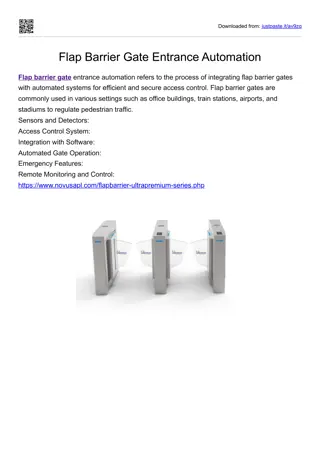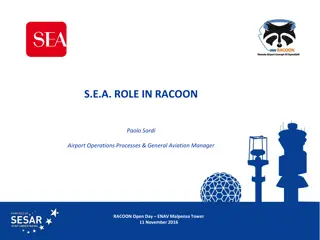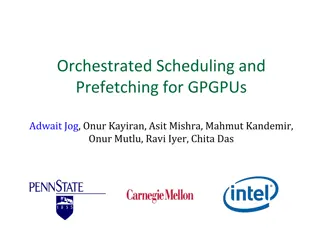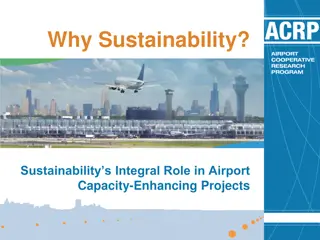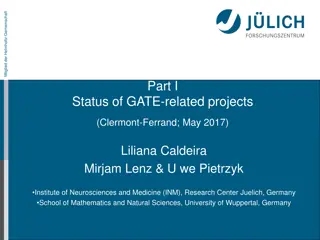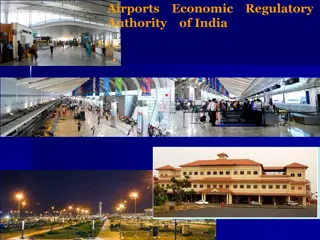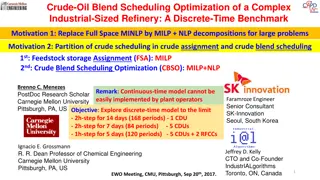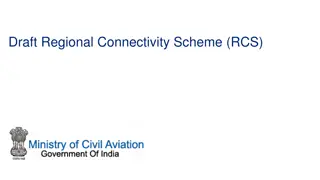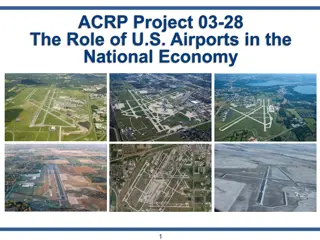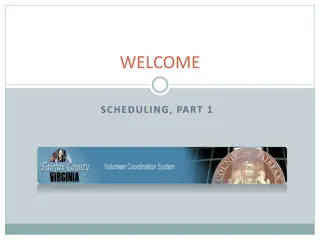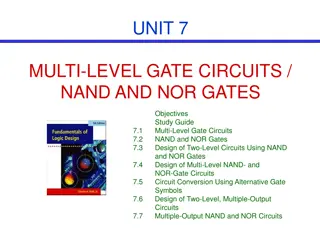Gate Scheduling at Airports: Optimization and Solutions
Allocating gates efficiently at airports is crucial for managing air traffic. Gate scheduling involves assigning flights to stands while considering constraints and objectives like minimizing un-gated activities and passenger walking distance. Various methods such as linear programming, heuristics, and meta-heuristics are used to solve the Gate Assignment Problem. The Primal-Dual Simplex Method is applied to minimize passenger walking distance by optimizing gate assignments based on passenger distance weights.
Download Presentation

Please find below an Image/Link to download the presentation.
The content on the website is provided AS IS for your information and personal use only. It may not be sold, licensed, or shared on other websites without obtaining consent from the author. Download presentation by click this link. If you encounter any issues during the download, it is possible that the publisher has removed the file from their server.
E N D
Presentation Transcript
Airport Gate Scheduling Laura Carandang, Jackie Li, Aparajita Maitra, Allison Peng
Airport Gate Scheduling Due to growth of air transport traffic, allocating airline and airport resources have become increasingly important There are several classes of decisions for which airport management is responsible (crew scheduling, ground operations, etc.) gate scheduling is the most important and complicated of these. Purpose of gate scheduling: to find an assignment of flights to aircraft stands and start and completion times for processing an aircraft at the position it has been assigned to.
The Gate Assignment Problem (GAP) A gate assignment must be suitable for airport services and convenient for passengers. Rules and constraints for a well-constructed schedule: 1. one gate can process only one aircraft at the same time 2. service requirements and space restrictions with respect to adjacent gates must be fulfilled 3. minimum ground time and minimum time between subsequent aircraft have to be assured. Some objectives: 1. the number of un-gated (open) aircraft activities must be minimized, 2. preferences of certain aircraft for particular gates have to be maximized 3. total walking distance for passengers must be minimized 4. the deviation of the current schedule from a reference schedule must be minimized in order to increase schedule attractiveness and passenger comfort
Solving the GAP Problems: 0-1 Linear Program, Integer Program, Dynamic Programming Algorithms: Genetic, Greedy, Branch and Bound Heuristic: First Unused Gate Assignment, Most Unused Gate Assignment Meta-Heuristic: Tabu Search, Simulated Annealing, Hybrid of Simulated Annealing with Tabu Search, Bee Colony Optimization
Primal-Dual Simplex Method l = # arrival gates k = # departure gates m = # arrival flights Objective: Min. ci,jxi,j and ci,jare elements of the matrix product of: PAX(i,j) * DIST(i,j)T Subject to: xi,j= 1 xj,i= 1 where i = 1,m & j =1,k PAX(i,j) = # passengers arriving on flight i and departing from gate j i = 1,m j = 1,k xi,j= {0,1} - This is an assignment problem that solves the objective of minimizing the walking distance that passengers must travel for a given arrival-departure cycle Objective function coefficients are passenger-distance weights for all possible assignments of arrival flights to arrival gates The xi,jconstraints ensure that a flight is assigned to only one arrival gate and that all flights are assigned DIST(i,j) = # passenger distance units from gate i to gate j i = 1,l j = 1,k - -
Visualization of the ci,j coefficients Solving the 0-1 Linear Program This assignment problem can be solved through the primal-dual simplex method Allows for sensitivity analysis Simplex multipliers inform us of the penalty paid for non-optimal solutions
Branch and Bound Branch and bound is a common mathematical programming technique used to find an optimal solution to the gate assignment problem. The objective is to reduce the number of passengers who have to walk maximum distances at the cost of more passengers having to walk the minimum distances, compared to random aircraft position assignment. In practice, a major airline hub terminal may handle more than 1000 daily flights at more than 50 gates, which in our formulation would result in billions of binary variables. Due to such a huge size, this model can not be handled by branch-and-bound based solvers within a reasonable time bound. Branch and Bound does not take into account transfer passengers -- would need to use greedy heuristics and linear programming relaxation to determine this.
Tabu Search GAP is complex, making it hard to find an optimal solution given time constraints Meta-heuristic algorithms such as tabu search efficiently deal with combinatorial optimization problems, helping to reach an optimal solution in reasonable time Tabu Search Objective: To maximize robustness of gate assignments meaning that the gate assignment is less sensitive to uncertain delays Solutions to this objective improve ramp operations and passenger experience
Insert Move Tabu Search Moves Interval Exchange Move Each gate has a list of equipment types that the gate can serve, as well as flights with incompatible equipment with the gate, making them unable to be assigned to that gate Iterations continue until there is no improvement of the objective value past the last best score
Summary of Analyses Tradeoffs are based on what you are trying to optimize when solving the GAP Branch and bound only solves for one objective: reduce the number of passengers who have to walk maximum distances so it is limited and not very practical Tabu search is more efficient than branch and bound, completing in a reasonable time when optimizing for robustness The 0-1 Linear Program (solved by the primal-dual simplex method) only considers fixed arrivals in a hub Inflexible because it does not account for uncertainties or changes in numbers of arrivals/departures Problems occur when the arriving flights are also departing flights with fixed destinations Best used for determination of initial gate assignments in a large hub and not the final assignments



